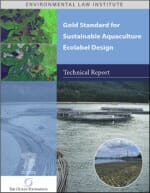Executive Summary
The aquaculture industry is on the rise: since 1950, aquaculture production has grown 8.8 percent per year and shows no signs of slowing. In 2004, global production stood at 59.4 million tons, with a market value of $70.3 billion.1
Proponents claim that this “blue revolution” reduces pressure on depleted wild fish stocks, provides a source of sustainable income generation for developing economies, and serves as an important food source to address protein deficits in developing regions. Unfortunately, these claims are undermined by serious environmental and social impacts caused by current aquaculture production practices.
These impacts range from dependence on wild feedstocks to trade imbalances, and each must be addressed before aquaculture development can be considered sustainable over the long term.
The Marine Aquaculture Task Force has noted that “ecolabelling, and certification have the potential to significantly improve the sustainability of aquaculture production practices.” 2 Ecolabels are intended to leverage consumer demand for sustainable products to provide incentives for adoption of improved environmental practices by producers. Certified producers can market their products with the ecolabel, indicating to consumers that the products meet certain production standards. Producers benefit from increased access to markets and price premiums for labeled products. This simple idea has been implemented through ecolabels in a wide array of industries ranging from forestry to capture fisheries. While the theory behind ecolabelling is the same from industry to industry, each label’s institutional design differs, as does its success on the ground. Design differences affect the label’s credibility and pragmatic benefits: labels must be properly designed to ensure that they produce their intended benefits. A number of ecolabels have already been developed in response to increasing demand for an aquaculture label, and more are forthcoming in coming months and years. However, existing and planned labels all focus on incremental improvements to production processes rather than on sustainability. In these labels, sustainability is more a buzzword than a guideline for implementation. Moreover, an independent review has revealed that all existing ecolabels lack credibility due in part to a lack of institutional controls and inadequate consideration of key impacts of production and processing. In addition, it is not clear that these efforts have resulted in improvements in environmental or social practices on the ground.
The Environmental Law Institute (ELI) and The Ocean Foundation (TOF) seek to introduce a new paradigm for ecolabelling in which sustainability—not feasibility—is the basis for certification. Sustainability is a high bar—it seeks economic development that does not degrade natural systems or undermine basic human needs for either this generation or future generations.3 Creation of an ecolabel that meets these disparate economic, environmental, and social goals requires careful and flexible institutional design to enable the evolutionary development of certification standards.
This Gold Standard describes a comprehensive framework for the design of an aquaculture certification that is based explicitly on environmental and social sustainability. The Gold Standard has been designed as efficiently as possible to ensure that it is both credible and practical. As a result, systems that follow the Gold Standard will comply with all established international design standards, will certify only sustainable operations and will provide economic benefits to producers over the long term. Through comprehensive consideration of effects on the environment, society, human health, and animal welfare, scientific standard-setting, careful controls on certification decisions, transparent review and reporting on performance, and robust objections procedures, consumers can be assured that Gold Standard-compliant ecolabels will successfully translate their rigorous standards into sustainable practices. Existing labels can also use the Gold Standard to evaluate their institutional design. These labels may improve the credibility of their systems by adopting elements of the Gold Standard.
The Gold Standard is based on the four elements of ecolabel design: (i) scope; (ii) governance structure; (iii) standards; and (iv) implementation methodology. Every ecolabel—based on sustainability or not—must consider each of these elements in order to design processes and substantive standards that are credible and offer incentives for producers to participate. The recommendations included for each of these elements in the Gold Standard are designed for optimal operation of a working sustainable aquaculture ecolabel given these requirements. The Gold Standard is a workable, comprehensive design framework for those who propose to create an ecolabel for aquaculture products. It uses sustainability as the minimum requirement for certification because only with substantively sustainable standards will aquaculture live up to its promise without causing undue harm.
1. FAO, State of World Aquaculture 2006 6 (2006).
2. Marine Aquaculture Task Force, Sustainable Marine Aquaculture: Fulfilling the Promise; Managing the Risks 110 (2007) [hereinafter Sustainable Marine Aquaculture]. The Marine Aquaculture Task Force is a diverse panel of experts with scientific, regulatory, business and policy-making backgrounds. It was convened by the Woods Hole Oceanographic Institution, with support from the Pew Charitable Trusts, to develop a suite of protective, science-based standards to assure that aquaculture development poses minimal threats to the ocean environment.
3. See John C. Dernbach, Synthesis, in Stumbling Toward Sustainability 1, 5–6 (2002); Michelle Allsopp et al., Challenging the Aquaculture Industry on Sustainability 19 (2008).
Further Reading
| - | You can view the full report by clicking here. |
May 2008


